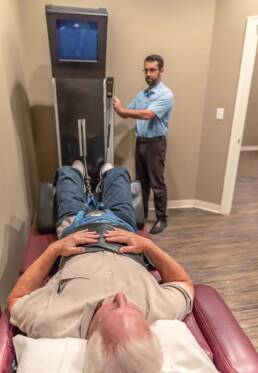Electrical stimulation therapy has gained a lot of attention over the last 10 years, with treatment options becoming increasingly available. While you may have known someone who has received some form of this therapy, it’s important to dig deeper to understand it for yourself. Discover what electrical stimulation therapy is, six benefits you may experience, and the details about receiving the therapy.
What Is Electrical Stimulation Therapy?
Electrical stimulation therapy goes by several names and has two distinct types of therapy. What most people are familiar with is what’s known as transcutaneous electrical nerve stimulation, also called TENS. This particular type of unit focuses on interrupting the pain signals before they can reach the spinal cord and brain.
The other type of electrical stimulation therapy is electrical muscular stimulation or EMS. Some people also refer to it as neuromuscular electrical stimulation or NMES. Rather than stimulating the nerve endings, it focuses on stimulating the muscles, causing them to contract.
In both cases, the device uses the electrical pulses sent through the skin to target nerves or muscles using adhesive pads. Electrical stimulation has three primary variables your provider can control which change the outcome. This includes the frequency measured in hertz or Hz, the intensity or amplitude that’s measured in milliamps or mA, and the type of wave generated. This is why it’s important to work with a trained professional to get the best possible results.
Benefits of Electrical Stimulation Therapy
Now that you understand a little more about what electrical stimulation therapy is, let’s explore the benefits. Many patients report some of the following benefits, while some are more subtle or only applicable in certain circumstances.
Reduce Pain and Discomfort
The most common reason people seek electrical stimulation therapy is for help with dealing with pain. How electrical stimulation therapy reduces pain depends on the type of electrical stimulation received.
High-frequency stimulation has demonstrated an increase in the amount of beta-endorphins contained in cerebrospinal fluid. Beta-endorphins are a type of chemical your body makes to block pain. When we talk about high-frequency therapy, this usually refers to units that produce 50-100 Hz.
Low-frequency stimulation activates specific cellular receptors to make them more receptive to other chemicals that reduce neuron activity in one of the structures in the spine known as the dorsal horn. All of the pain-sensing nerves connect to this structure, which transmits pain signals to the brain. Making that structure more receptive to pain-blocking chemicals helps you to prevent or reduce the transmission of those pain signals to the brain.
Improve Muscular Blood Flow
The muscle contraction that comes with electrical muscle stimulation works like a pump for blood flowing into and out of the muscle. Think of it like the old hand pumps that brought up water each time you pumped the handle.
Your muscle works the same way, drawing more blood through it with each contraction. This is important because the new blood that arrives with each pump brings with it more oxygen and helps remove metabolite toxins.
There are a couple of reasons this increased blood flow is important. First, your body uses oxygen to break down glucose and create usable fuel for your muscles. Second, as the outgoing blood removes more toxins, your muscles will experience less soreness, faster workout recovery, and improved tissue health.
Preserve Muscle Tone
It can be difficult to maintain muscle tone when you’re in pain or when you’re recovering from an injury. Part of the challenge is needing to keep bones or joints immobilized to allow them to heal without aggravating them. However, the muscle in the immobile part of your body will atrophy within two or three weeks.
EMS is a perfect treatment to prevent the atrophy without putting strain on areas that are recovering or that hurt. The stimulation causes contractions similar to what you would experience during a workout. The difference is that they are very rapid, which gives the targeted muscles a more intense workout than you might otherwise get from traditional exercise. The result is toning muscle when you might not have other viable options given your condition.
Reduce Joint Swelling
Inflammation is a natural part of the body’s healing process to help immobilize injured joints and bring healing compounds and nutrients to the injury. However, it’s also inflammation that exacerbates pain throughout the body and can lead to other issues.
The body works by sending and receiving signals through the nervous system What triggers inflammation is the signal into the system that you’ve experienced pain or an injury. That gets received, and immediately the body sends its healing immune response through inflammation. It then waits for other signals to indicate that the injury is no longer an issue and the inflammation is no longer needed.
Electrical stimulation uses signals that mimic some of what’s naturally sent along the nerves. This has the dual effect of arresting pain signals so that they never reach the brain. It further sends the signals needed to flip the switch on inflammation, indicating that it’s no longer needed. Finally, as previously mentioned, it helps improve the waste process through the swollen muscles, allowing them to better flush the excessive fluid.
Accelerated Recovery For Some Injuries
In addition to pain relief and reducing inflammation, electrical stimulation therapy may also help accelerate healing for some injuries. That additional blood flow we mentioned earlier is critical to help injuries heal. It is well established that oxygen is necessary for wounds to heal properly, so bringing more blood-borne oxygen to the area is important. Further, that extra blood is also carrying additional nutrients and white blood cells that are part of the immune system’s design for healing wounds and injuries.
Who Isn’t A Good Candidate for Electrical Stimulation Therapy?
As you can see, there are a number of reasons why your provider may recommend electrical stimulation therapy. However, there are some considerations of who is a good candidate versus those who are not.
First, anyone with an implanted medical device like a pacemaker, defibrillator, or even an insulin pump should not receive any form of EMS. It could also cause some complications with individuals with certain heart conditions, so be sure to discuss your full medical history with your provider before receiving EMS or TENS therapy.
Most providers recommended pregnant women avoid electrical stimulation therapy. However, some research is surfacing that suggests it may be safe during pregnancy, like this 1999 study on pregnant rats. It’s best to discuss with a chiropractor who specializes in prenatal chiropractic care for individualized advice.
How Does Electrical Stimulation Therapy Feel?
If you’ve never received electrical stimulation therapy before, you may have concerns over how it will feel. The impulses generated during electrical stimulation therapy mimic those your brain uses to cause muscle contractions.
Most patients report feeling a tingling, but don’t report pain or discomfort associated with the treatment. In fact, many patients report feeling better during and after the therapy session. Part of this is because the impulses signal to the brain to speed up the production of endorphins, which make you feel good and help block pain.
How Often Can You Receive Treatments?
With all of the benefits you can gain from electrical stimulation therapy, it’s important to consider how often you can receive treatment. This is dependent on the kind of stimulation therapy you’re receiving.
The major concern is the amount of contracting your muscles experience during treatment. If you’re receiving high-frequency treatment that causes strong muscle contractions, you’ll need to give them a break to recover, just like if you went to the gym. That means taking a few days between treatments to allow your muscles a chance to recover.
However, if you’re receiving low-frequency treatment for pain that doesn’t really activate your muscles, then it’s safe to get treatments as often as you and your provider deem prudent. The key is working with your provider to find the proper treatment schedule for the goals of your therapy.
Risks of Electrical Stimulation Therapy
The medical community considers electrical stimulation therapy as generally safe with few adverse reactions reported by good candidates for the treatment. Some people are sensitive to the adhesive used to attach the electrode to the skin and may develop skin irritation or a rash. Very rarely patients experience burns at the site of the electrode.
Improper electrode placement may cause spasticity in the muscle. Likewise, if the intensity is too high it can cause sore muscles. Neither of these side effects is dangerous, and both are avoidable when you see a qualified practitioner.
Call to schedule your Conroe area electrical stimulation therapy consultation with the experts at Freedom Chiropractic.

Ready for a complimentary consultation? Get in touch today!
Much like an engineer, we focus on setting up your body to do the activities that you want to do most. An engineer would make sure a bridge could accommodate Houston traffic, and we will make sure your body can accommodate your favorite sport, family activity, or your next adventure.
Like this article? Spread the word!
Related Posts
July 15, 2024
Enhancing Your Health Naturally: How Freedom Chiropractic in Conroe, TX Can Help
Experience the power of natural healing at Freedom Chiropractic in Conroe, TX. Our…
June 19, 2024
Discover Freedom Chiropractic: Your Path to Wellness in Conroe, TX
Discover Freedom Chiropractic in Conroe, TX, where Dr. Tony Brooks and our team offer…
May 15, 2024
Unlocking Wellness: The Comprehensive Guide to Chiropractic Care in Conroe, TX
Discover comprehensive chiropractic care in Conroe, TX at Freedom Chiropractic. Our…




